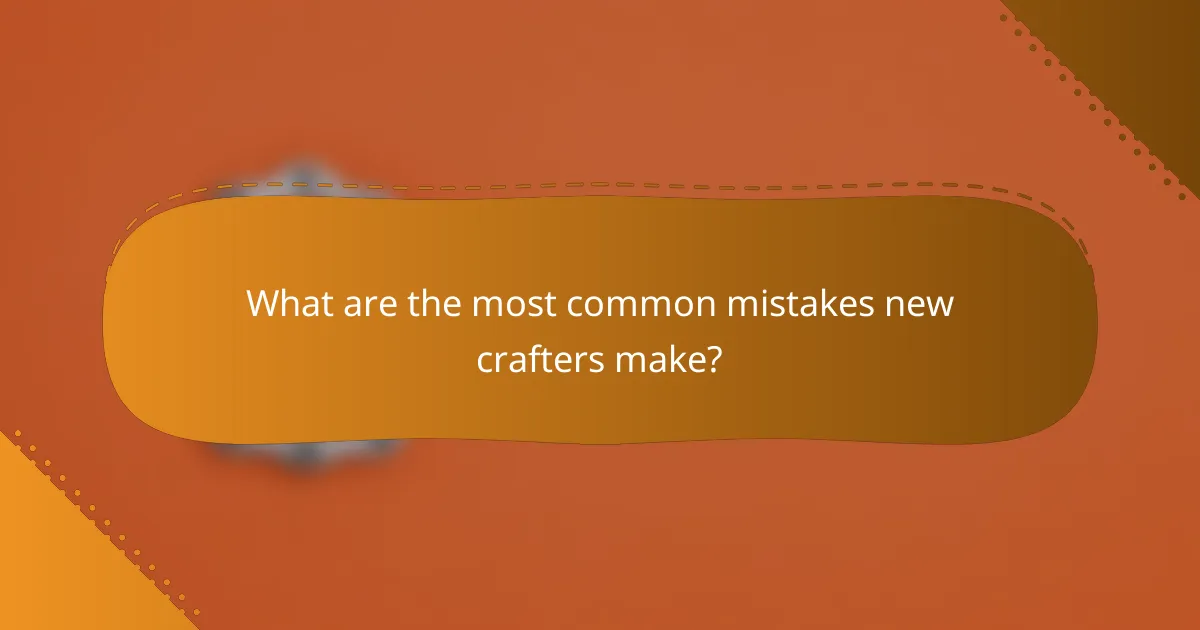Starting your crafting journey can be exciting, but new crafters often face common mistakes that can dampen their enthusiasm. By understanding these pitfalls and focusing on essential practices, you can enhance your skills and enjoy a more fulfilling crafting experience. Investing in quality tools and planning your projects carefully will set you on the path to success.

What are the most common mistakes new crafters make?
New crafters often encounter several pitfalls that can hinder their progress and enjoyment. Recognizing these common mistakes can help improve skills and lead to more successful projects.
Overlooking essential tools
Many beginners underestimate the importance of having the right tools for their crafting projects. Essential tools can vary by craft but typically include items like scissors, cutting mats, and adhesives. Investing in quality tools can significantly enhance the crafting experience and outcomes.
Before starting a project, create a checklist of necessary tools to ensure you have everything on hand. This prevents interruptions and frustration during the crafting process.
Ignoring project planning
Failing to plan a project can lead to wasted materials and time. A clear plan helps outline the steps, materials needed, and expected timeline. This approach not only saves resources but also boosts confidence as you work through your project.
Consider sketching your design or writing down a step-by-step guide. This can serve as a roadmap, making it easier to stay organized and focused throughout the crafting process.
Neglecting skill development
New crafters sometimes dive into complex projects without building foundational skills first. Taking the time to learn basic techniques can prevent frustration and improve the quality of finished work. Skill development can include practicing stitches, cuts, or assembly methods relevant to your craft.
Look for tutorials, classes, or online resources that focus on fundamental skills. Regular practice will lead to greater mastery and confidence in your crafting abilities.
Underestimating material costs
Many beginners fail to accurately estimate the costs of materials, which can lead to budget overruns. It’s important to research and calculate the total cost of supplies before starting a project. This includes not just the main materials but also any additional items like tools or embellishments.
Create a budget for each project and track your spending. This practice helps avoid surprises and ensures you can complete your project without financial stress.
Skipping safety precautions
Safety is often overlooked by new crafters, especially when using sharp tools or chemicals. Always prioritize safety by wearing appropriate gear, such as goggles or gloves, and following guidelines for tool use. This reduces the risk of injury and creates a more enjoyable crafting environment.
Familiarize yourself with safety practices specific to your craft. For example, if working with hot glue or cutting tools, ensure you understand how to use them safely to prevent accidents.

How can new crafters avoid these mistakes?
New crafters can avoid common pitfalls by focusing on essential practices that enhance their skills and ensure successful projects. By investing in quality tools, planning projects carefully, and following safety guidelines, beginners can create a more enjoyable crafting experience.
Invest in quality tools
Using quality tools is crucial for achieving better results in crafting. High-quality scissors, cutting mats, and adhesives can make a significant difference in the ease and precision of your work. While they may cost more upfront, these tools often last longer and improve the overall crafting experience.
Consider starting with a few essential tools that are well-reviewed by other crafters. For instance, a reliable rotary cutter or a sturdy glue gun can be invaluable for various projects. Investing in tools that suit your crafting style will pay off in the long run.
Create a detailed project plan
A detailed project plan helps new crafters stay organized and focused. Outline the steps needed to complete your project, including materials, techniques, and time estimates. This preparation minimizes mistakes and wasted materials.
Break down your project into manageable tasks, and set realistic deadlines for each phase. For example, if you’re making a quilt, plan to cut fabric one day, sew the pieces together another day, and finish with quilting and binding. This structured approach can lead to a more satisfying crafting experience.
Enroll in crafting workshops
Participating in crafting workshops can significantly enhance your skills and knowledge. These hands-on sessions provide valuable guidance from experienced crafters and allow you to learn new techniques in a supportive environment. Look for local workshops or online classes that match your interests.
Workshops often cover a range of topics, from basic techniques to advanced skills. Engaging with fellow crafters can also inspire creativity and foster a sense of community, making your crafting journey more enjoyable.
Budget for materials
Budgeting for materials is essential to avoid overspending and ensure you have everything needed for your projects. Start by estimating the costs of materials based on your project plan, and consider setting aside a specific amount each month for crafting supplies.
Keep an eye out for sales and discounts at local craft stores or online retailers. Buying in bulk can also save money, especially for frequently used items like yarn or fabric. A well-planned budget helps maintain your crafting enthusiasm without financial strain.
Follow safety guidelines
Following safety guidelines is vital to prevent accidents while crafting. Always read the instructions for tools and materials, and use them as intended. For instance, when working with sharp tools or hot glue, take necessary precautions to protect yourself.
Consider wearing safety gear, such as goggles or gloves, when appropriate. Additionally, ensure your workspace is well-lit and organized to minimize hazards. Being mindful of safety can help you enjoy crafting without unnecessary risks.

What tools are essential for new crafters?
New crafters should start with a few essential tools that will serve multiple purposes across various projects. Having the right tools can significantly enhance your crafting experience and help you avoid frustration.
Basic crafting toolkit
A basic crafting toolkit typically includes items like scissors, a cutting mat, a craft knife, glue, and a ruler. These tools are versatile and can be used in a wide range of crafting activities, from paper crafts to fabric projects.
Consider adding a self-healing cutting mat to protect your work surface and prolong the life of your blades. A good pair of scissors is crucial; opt for a pair that feels comfortable in your hand and can handle various materials.
Specialized tools for specific crafts
Depending on your chosen craft, you may need specialized tools. For instance, if you’re into sewing, a sewing machine, pins, and fabric shears are essential. For paper crafting, a paper trimmer and embossing tools can elevate your projects.
Research the specific requirements of your craft to avoid overspending on unnecessary tools. Start with a few key items and expand your toolkit as you gain experience and confidence in your crafting skills.
Recommended brands for beginners
For beginners, brands like Fiskars, Cricut, and Elmer’s offer reliable tools at accessible prices. Fiskars is known for its quality scissors and cutting tools, while Cricut specializes in electronic cutting machines that can simplify complex projects.
Look for starter kits from these brands that bundle essential tools together, providing good value and ensuring you have what you need to get started. Always check customer reviews to gauge the performance and durability of the tools you consider purchasing.

What are effective strategies for skill enhancement?
Effective strategies for skill enhancement in crafting include consistent practice, engaging with crafting communities, and leveraging online tutorials. These approaches help crafters refine their techniques, gain new insights, and stay motivated.
Practice regularly
Regular practice is essential for improving crafting skills. Set aside dedicated time each week to work on your projects, even if it’s just a few hours. This consistency helps develop muscle memory and enhances your overall proficiency.
To make the most of your practice sessions, focus on specific techniques or materials each time. For example, if you’re learning to knit, dedicate one session to mastering a new stitch and another to completing a small project. This targeted approach can lead to quicker skill development.
Join crafting communities
Joining crafting communities, whether online or in-person, can significantly enhance your skills. These groups provide a platform for sharing ideas, receiving feedback, and learning from others’ experiences. Look for local craft clubs or online forums that align with your interests.
Participating in community events, such as workshops or craft fairs, can also expose you to new techniques and materials. Engaging with fellow crafters fosters a supportive environment where you can ask questions and gain inspiration.
Utilize online tutorials
Online tutorials are a valuable resource for crafters at any skill level. Platforms like YouTube, craft blogs, and dedicated crafting websites offer a wealth of instructional videos and step-by-step guides. These resources allow you to learn at your own pace and revisit complex techniques as needed.
When selecting tutorials, choose those that match your current skill level and interests. Start with beginner-friendly content and gradually progress to more advanced projects. This approach helps build confidence and ensures a solid foundation for future crafting endeavors.

How can new crafters budget effectively?
New crafters can budget effectively by estimating material costs, tracking expenses, and seeking discounts. These strategies help manage spending and ensure that crafting remains enjoyable and affordable.
Estimate material costs accurately
Accurate estimation of material costs is crucial for budgeting. Start by listing all the supplies needed for your project, including tools, materials, and any additional items. Research prices online or at local craft stores to get a realistic idea of what you will spend.
Consider using a spreadsheet to track costs as you gather information. This will help you see the total amount required and adjust your project scope if necessary. Aim for a budget range that allows for some flexibility, typically adding an extra 10-20% for unexpected expenses.
Track expenses with budgeting apps
Using budgeting apps can simplify tracking your crafting expenses. Many apps allow you to categorize spending, set limits, and monitor your budget in real-time. Popular options include Mint, YNAB (You Need A Budget), and PocketGuard.
When selecting an app, look for features that suit your needs, such as expense tracking, reminders for upcoming purchases, and visual spending reports. Regularly updating your expenses will help you stay within budget and make informed decisions about future projects.
Look for discounts and sales
Finding discounts and sales is an effective way to stretch your crafting budget. Sign up for newsletters from craft stores to receive notifications about promotions, coupons, and sales events. Many stores offer loyalty programs that provide additional savings.
Additionally, consider shopping during major sales events like Black Friday or holiday sales when discounts can reach significant percentages. Online platforms like Etsy or Amazon often have deals on crafting supplies, so compare prices before making a purchase.


